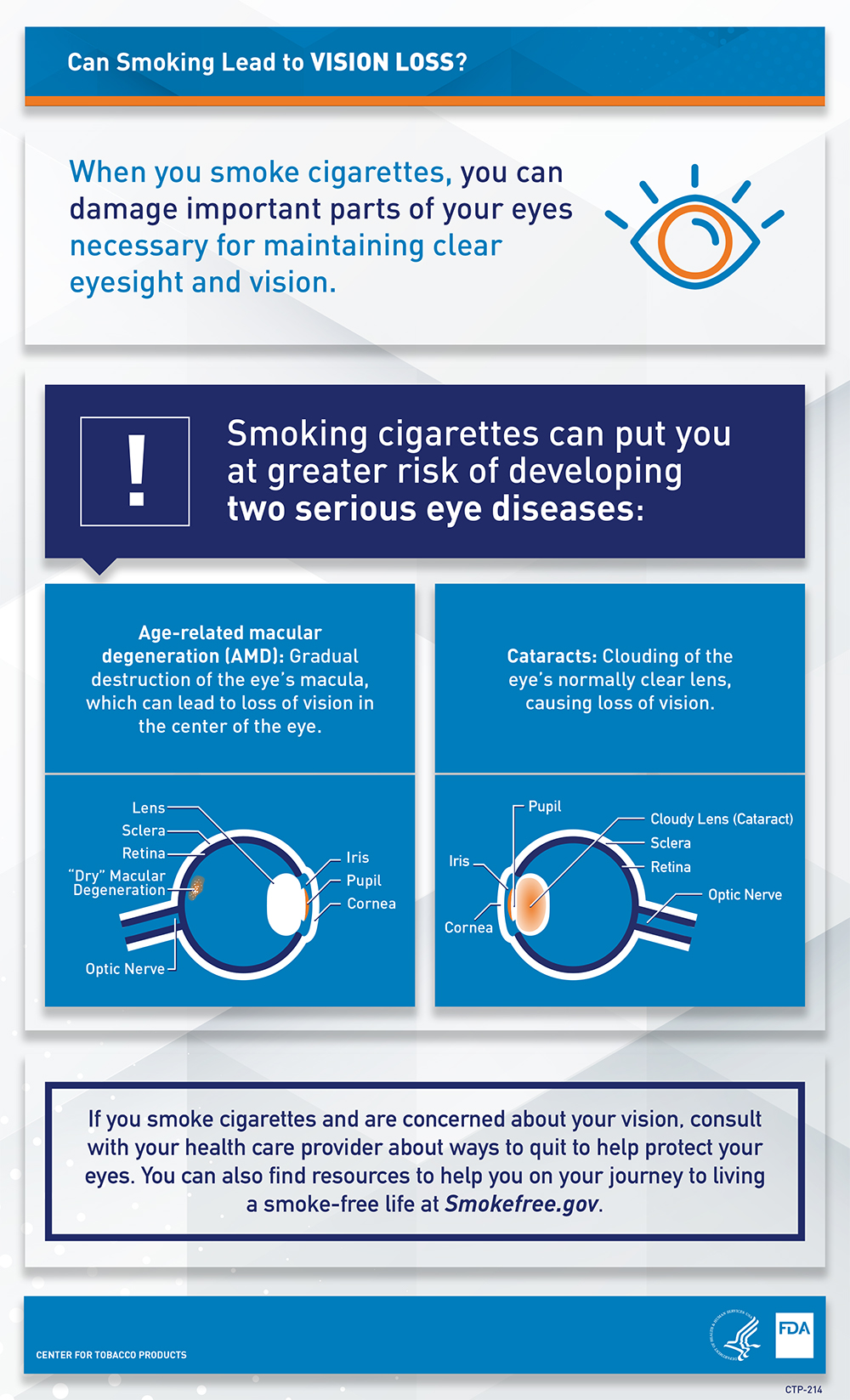Webpage
How Smoking Can Contribute to Vision Loss and Blindness
Preview Text for Your Web Page
The following text is a preview of content you can place on your website.
How Can Smoking Affect My Eyesight and Vision?
When you smoke cigarettes, you can damage important parts of your eyes necessary for maintaining clear eyesight and vision. This damage can make your vision cloudy, reduce your field of vision, or even cause you to lose your eyesight completely.
Smoking cigarettes can affect your:
- Retina: The delicate, light-sensitive tissue that lines the inside of the eye.
- Lens: The clear part of the eye that allows light to pass to the retina and allows the eye to focus on objects at varying distances.
- Macula: The most sensitive part of the retina and is the part of the eye that supplies sharp vision.1
Order Free Print Version | Download Infographic

Can Smoking Lead to Vision Loss and Blindness?
Yes, smoking cigarettes can cause eye diseases that can lead to vision loss and blindness. Smoking cigarettes can put you at greater risk of developing two serious eye diseases:
- Cataracts: Clouding of the eye’s normally clear lens, causing loss of vision.
- Age-related macular degeneration (AMD): Gradual destruction of the eye’s macula, which can lead to loss of vision in the center of the eye.
People who smoke cigarettes are two to three times more likely to develop cataracts2 and up to four times more likely to develop AMD than people who don’t smoke.3
What Are Symptoms of Eye Diseases Related to Smoking?
Smoking cigarettes can cause two serious eye diseases: cataracts and age-related macular degeneration (AMD). Symptoms of these eye diseases related to smoking include:
- Cloudy or blurry vision
- Colors that seem faded
- Sensitivity to light
- Trouble seeing at night
- Double vision
AMD:
- Loss of the central vision you need to see details straight ahead
- Blurry or wavy areas in your central vision
- Having a hard time recognizing faces
- Needing more light to read or do other tasks in front of you
You should be aware that in the early stages of both eye diseases you may experience no symptoms at all. It’s important to get eye exams on a regular basis to increase the chances of catching and treating these conditions as early as possible.
Can Smoking Cause Cataracts?
Yes, smoking cigarettes can cause cataracts. People who smoke cigarettes are two to three times more likely to develop cataracts than people who don’t smoke.2
A cataract is the clouding of the eye’s lens, which is normally clear. Cataracts cause loss of vision because the clouding prevents light from passing through the lens to the retina.
Most cataracts develop slowly over the course of years and the risk for developing cataracts goes up as you get older. Smoking further increases your chance of developing cataracts.
You may not notice symptoms of cataracts at first. But as cataracts worsen, they can affect your ability to see clearly.
Can Smoking Cause Age-Related Macular Degeneration (AMD)?
Yes, smoking cigarettes can cause AMD.1 People who smoke cigarettes are up to four times more likely to develop AMD than people who don’t smoke.3
The retina is the delicate, light-sensitive tissue that lines the inside of the eye. AMD is an eye disease that affects your macula, the most sensitive part of the retina and the part of the eye that supplies sharp vision.
When you develop AMD, it gradually destroys the macula and can ultimately lead to loss of vision in the center of the eye. This can make it difficult to see or do things in front of you, such as recognize faces, read, drive, or perform chores around the house.
AMD can progress quickly or slowly, depending on the person and their risk. Your risk for developing AMD goes up as you get older and is higher if you smoke cigarettes.
Since AMD is a common condition, especially in older adults, and you may not notice symptoms for a long time, it is important to have regular eye exams.
Can Smoking Cause Graves’ Ophthalmopathy or Thyroid Eye Disease?
More research is needed to find out whether smoking cigarettes can cause ophthalmopathy associated with Graves’ disease. Graves’ ophthalmopathy, also known as Graves’ eye disease or thyroid eye disease, can cause irritation, sensitivity, double vision, and other symptoms in the eyes as a result of an overactive thyroid caused by Graves’ disease.
The data from research conducted on the relationship between smoking and Graves’ ophthalmopathy is not strong enough to conclude that smoking is a cause of thyroid eye disease. However, some evidence suggests that smoking cigarettes can put you at an increased risk for Graves’ eye disease if you have Graves’ disease.1,2 Since the role of smoking in Graves’ ophthalmopathy is unclear, more research is needed.
Can Smoking Cause the Onset or Progression of Diabetic Retinopathy?
More research is needed to find out whether smoking cigarettes can cause the onset or progression of retinopathy in people with diabetes.1,2 Diabetic retinopathy affects the blood vessels in your retina, the delicate, light-sensitive tissue that lines the inside of the eye, and can cause vision loss and blindness in people who have diabetes.
Can Smoking Cause Glaucoma?
More research is needed to find out whether smoking cigarettes can cause glaucoma. Glaucoma is a group of eye diseases that can cause vision loss and blindness by damaging a nerve in the back of your eye called the optic nerve.
The data from research conducted on the relationship between smoking and glaucoma does not tell us whether smoking is a cause of glaucoma.1,2
How Can Quitting Smoking Protect My Eyes?
You can lower your risk of developing cataracts and age-related macular degeneration by quitting smoking cigarettes.
It can be overwhelming to experience changes in your vision. If you smoke cigarettes and are concerned about your eyesight, speak with your health care provider and schedule an eye exam.




